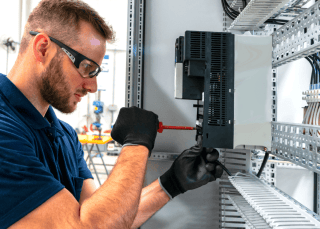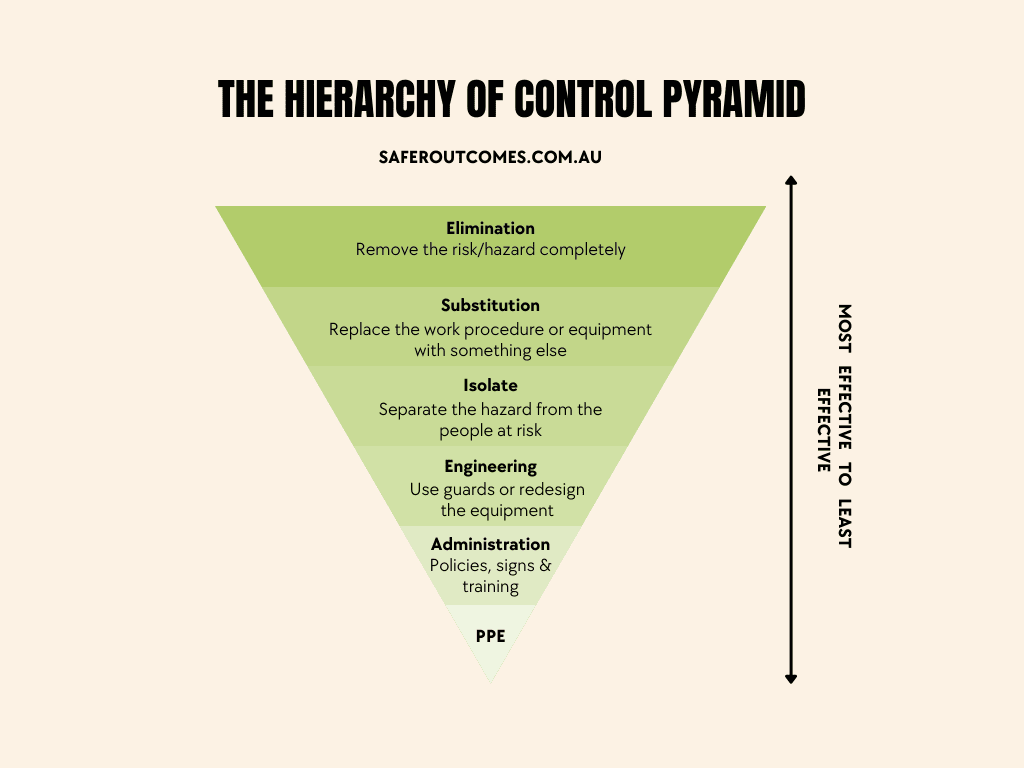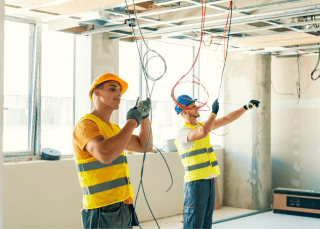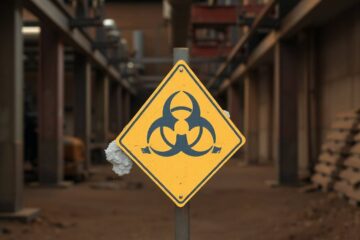The construction industry, known for its inherent risks, demands a high level of caution and adherence to safety standards, particularly for electricians. In Australia, where safety regulations are among the most rigorous in the world, electricians are required to navigate the challenges of working with live electrical systems while ensuring their own safety and that of their colleagues.
Embracing a culture of safety involves understanding and implementing a range of precautions, from personal protective equipment (PPE) to detailed safety plans and manuals. Ensuring safety requires not only individual vigilance but also a collective commitment to following stringent practices and protocols. This article delves deeper into essential safety precautions, offering a comprehensive guide for electricians aiming to mitigate risks on construction sites.
What Hazards and Risks do Electricians Face on Construction Sites?
Electricians working on construction sites are exposed to a wide range of hazards and risks that can significantly impact their health and safety. Understanding these risks is the first step towards mitigating them effectively. Here are some of the primary hazards and risks electricians face:
1. Electrical Shocks and Burns
One of the most direct risks to electricians is the threat of electrical shocks and burns. This can occur when electricians come into contact with live wires, faulty equipment, or when there is improper grounding. The severity can range from minor shocks to fatal electrocutions, underscoring the need for strict adherence to safety protocols.
2. Falls from Heights
Electricians often work at heights, installing wiring or electrical fixtures on rooftops, scaffolding, or ladders. Falls from such heights can lead to serious injuries or death, highlighting the importance of fall protection measures, including harnesses, guardrails, and safe ladder practices.
3. Confined Spaces
Working in confined spaces, such as crawl spaces or attics, presents unique challenges, including limited mobility, reduced ventilation, and increased risk of encountering live wires. These conditions not only heighten the risk of electrical shock but can also lead to asphyxiation or difficulty escaping in an emergency.
4. Exposure to Hazardous Materials
Electricians may be exposed to hazardous materials, such as asbestos in older buildings or lead in old paint, which pose significant health risks. Inhalation or ingestion of these substances can lead to chronic health issues, including respiratory problems and lead poisoning.
5. Fire and Explosion Risks
The risk of fires and explosions is elevated in areas where electrical work is being conducted, especially if flammable materials are present. Short circuits, overloaded systems, or faulty installations can ignite fires, endangering not only electricians but also other workers on site.
6. Tools and Equipment Injuries
The use of hand and power tools, while essential for electrical work, also presents risks of injuries ranging from cuts and abrasions to more severe injuries from tools malfunctioning or misuse. Regular maintenance and correct usage of tools are crucial to prevent such incidents.
7. Musculoskeletal Injuries
Electricians frequently engage in bending, lifting, and working in awkward positions, leading to musculoskeletal injuries. These can include strains, sprains, and chronic back problems, which can be mitigated through proper ergonomics and lifting techniques.
8. Arc Flashes and Blasts
Arc flashes and blasts, resulting from a sudden release of electrical energy through the air, pose a significant risk to electricians. These incidents can cause severe burns, blindness, or even death, necessitating strict controls and protective gear to mitigate the risk.
Understanding these hazards and implementing comprehensive risk management strategies, including safety training, use of appropriate PPE, and adherence to safety protocols, are fundamental in protecting electricians from the inherent dangers of working on construction sites.

How to keep electricians safe on construction sites?
Integrating the hierarchy of control into safety precautions for electricians on construction sites provides a structured approach to managing and mitigating risks. This system prioritizes risk control methods from most to least effective, ensuring that safety measures are systematically applied. Below are sections incorporating the hierarchy of control, focusing on its application to electrical safety in construction environments.
Understanding the Hierarchy of Control
The hierarchy of control is a framework used to manage workplace hazards and risks, categorized into several levels: elimination, substitution, engineering controls, administrative controls, and personal protective equipment (PPE). By applying this framework, electricians and safety managers can more effectively reduce risks on construction sites.
1. Elimination
Removing Electrical Hazards: The most effective method in the hierarchy of control is to eliminate the hazard entirely. For electricians, this could mean designing construction projects in a way that minimizes the need for workers to be exposed to live circuits, or planning work to occur when the power supply can be safely shut off.
2. Substitution
Using Safer Alternatives: Substitution involves replacing something that poses a hazard with a less hazardous option. This could involve using battery-operated tools instead of those requiring a mains supply, to reduce the risk of electric shock or using lower voltage equipment where possible.
3. Engineering Controls
Isolating People from Hazards: Engineering controls involve redesigning tools, equipment, or the work environment to reduce exposure to hazards. Examples include installing ground-fault circuit interrupters (GFCIs) to prevent electrical shock, or using enclosed cabling systems to protect against physical and electrical hazards.
4. Administrative Controls
Changing Work Practices and Procedures: Administrative controls include implementing safe work practices, such as scheduling high-risk tasks during low-activity periods, conducting regular safety meetings, and ensuring clear signage and marking of electrical hazards. Training and education on electrical safety, risk assessments, and the development of Safe Work Method Statements (SWMS) are also key administrative controls.
5. Personal Protective Equipment (PPE)
Using Safety Gear to Protect Workers: As the last line of defense, PPE is essential but should be relied on only after higher-order controls have been considered. For electricians, appropriate PPE includes insulated gloves and footwear, safety glasses, face shields for arc flash protection, and flame-resistant clothing.

Implementing the Hierarchy of Control on Construction Sites
Implementing the hierarchy of control requires a proactive approach to identifying potential electrical hazards and assessing which level of control can effectively mitigate the risk. This process should be iterative, with regular reviews of control measures to ensure they remain effective as site conditions and work scopes evolve.
Safety Planning and Continuous Improvement
Safety planning should incorporate the hierarchy of control from the project’s outset, with continuous improvement based on regular risk assessments and feedback from electricians and other workers on site. This ensures that the most effective control measures are in place and adapted to changing conditions and new technologies.
Collaboration and Communication
Effective implementation of the hierarchy of control also relies on strong collaboration and communication among all stakeholders on a construction site, including electricians, project managers, and safety officers. Sharing knowledge and experiences can lead to innovative solutions that further enhance safety.
Applying the hierarchy of control in electrical safety practices on construction sites offers a comprehensive and effective strategy for minimizing risks. By prioritizing elimination and substitution, and supporting these with engineering, administrative, and PPE controls, electricians can ensure a safer work environment. This approach not only protects workers but also contributes to the overall success and efficiency of construction projects by reducing the potential for accidents and downtime.
8 Ways Electricians can keep safe on a construction site
Understand and Comply with Australian Standards and Legislation
Compliance with Australian standards, and national and state-specific legislation, is non-negotiable for electricians. These regulations are designed to uphold the highest safety standards and are regularly updated to reflect new technologies and practices. Electricians must stay informed about these changes and understand how they apply to their work. This includes being aware of the Electrical Safety Act and any relevant codes of practice that impact electrical work on construction sites.
Use Personal Protective Equipment (PPE)
The correct use of PPE is fundamental to an electrician’s safety. This includes wearing insulated gloves and footwear, safety goggles, hard hats, and high-visibility clothing. Each piece of PPE serves a specific purpose, from preventing electric shock to protecting against physical injuries. Regular training on the correct use and maintenance of PPE is essential to ensure it provides the intended protection.
Implement Lockout-Tagout (LOTO) Procedures
LOTO procedures are critical for preventing the accidental energisation of electrical systems. These procedures involve turning off the power source, locking the device to prevent re-energisation, and tagging it to indicate that maintenance is being performed. Electricians must be trained in the correct application of LOTO procedures and should never assume equipment is de-energised without verifying it themselves.
Conduct Risk Assessments
Before commencing any electrical work, a thorough risk assessment should be conducted to identify potential hazards and develop strategies to mitigate them.Â
Safe Work Method Statements (SWMS)
For high-risk construction work, including certain electrical tasks, an SWMS is required. This document outlines the work to be carried out, the hazards associated with it, and the measures to control these risks. Developing and following an SWMS ensures that work is performed safely and in compliance with regulatory requirements.
Toolbox Talks
Regular toolbox talks are an effective way to communicate safety information, discuss specific hazards related to electrical work, and reinforce the importance of following safety procedures. These brief, informal meetings can be used to review SWMS, discuss incidents or near misses, and ensure that all team members are aware of their safety responsibilities.
Communicating and Consulting with Other Trades on Site
Electrical work on construction sites often intersects with the work of other trades. Effective communication and consultation with these trades are vital to identify and manage potential hazards that could affect safety. This includes coordinating activities to prevent electrical hazards and ensuring that other workers are aware of the presence of electrical work areas.
Having a Safety Plan/Manual
A comprehensive safety plan or manual is indispensable for outlining the specific safety practices, emergency procedures, and PPE requirements related to electrical work. This document should be accessible to all workers, and its contents should be familiar to the entire team. Regular training sessions can help ensure that the safety plan is understood and followed.

Keeping other tradies safe too!
On construction sites, electricians work closely with lots of other skilled workers, like carpenters, plumbers, and builders. It’s super important for everyone to talk to each other and work together to stay safe. Here’s a simpler look at how electricians can keep things safe by communicating well with other trades.
Spotting Dangers Together
Before anyone starts their work, it’s a good idea for electricians and other workers to have a chat about what they’ll be doing. This way, they can:
- Have Regular Meetings: These are times when workers from different jobs come together to talk about what work they’ll be doing soon. They can figure out if one job might cause problems for another and plan to avoid any mix-ups.
- Look Around Together: Sometimes, walking around the site with workers from other trades helps spot dangers that one group might not notice on their own.
Sharing What You Know
Electricians know a lot about keeping safe around electricity. Sharing this knowledge with others can really help keep everyone safe. They can:
- Quick Safety Chats (Toolbox Talks): These are short meetings where electricians can explain electrical dangers to other workers, especially about the work they’re about to do.
- Safety Messages: If there’s a new electrical danger on site, electricians can help by telling everyone about it, maybe through a quick note or a sign.
Planning Work to Avoid Electrical Dangers
Making a good plan means electricians and other workers can do their jobs without getting in each other’s way or risking safety. This includes:
- Making a Schedule: Sometimes, it’s safest to do electrical work when fewer people are around. Planning helps make this happen.
- Using Signs and Fences: Putting up signs and fences around areas where electricians are working warns others to be careful or stay out.
Knowing What to Do in Emergencies
If something goes wrong, everyone needs to know how to help and what to do next. This means:
- Emergency Numbers: Keeping a list of who to call in an emergency where everyone can see it.
- Practice Drills: Running through what to do in an emergency, like a fire or if someone gets shocked, so everyone knows how to react quickly.
Using Tech to Talk Better
There are some cool tools out there to help everyone stay on the same page, like:
- Project Apps: Apps where everyone can see updates about the work, safety tips, and any changes in plans.
- Chat Apps: Quick messaging apps can help everyone keep in touch and share information fast.
The main idea is that talking and working together helps keep everyone safe. Electricians have a big part to play by sharing their knowledge about electrical safety, planning their work carefully, and making sure they’re ready for any emergencies. When everyone communicates well, the construction site becomes a much safer place for everyone.

Conclusion
Safety on construction sites, particularly for electricians, requires more than just following rules. It involves a comprehensive approach that includes staying informed about regulations, using the right equipment, planning and assessing work, and maintaining open lines of communication with colleagues and other trades. By implementing detailed safety plans, adhering to SWMS, conducting regular toolbox talks, and fostering a culture of safety, electricians can significantly reduce the risks associated with their work. Remember, safety is a collective responsibility and a crucial component of professional practice on Australian construction sites.


